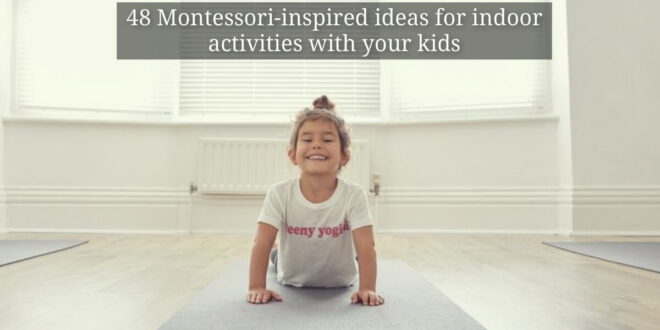Children need their run outside. All year round, kids have to go out to run and play. Summer and spring are the times where you will find many children playing games, riding bikes, and exploring the outside world. When the weather outside becomes cold, they will want to come back inside pretty quick. When winter comes, they will enjoy the snow and building snowmen and making snow angels on the ground but for at least 30 minutes to an hour, and then they will get cold and go back inside. That means that you have to be ready with indoor activities to make their time spent at home more fun. We will equip you with a list of ideas and activities you can do with your kids indoors when the weather outside isn’t good. Make sure that after doing the activity, put it somewhere or write it down so you kids can take it or choose it if they want to do it alone.
This is a list of 48 engaging and learning activities you can do with your kids indoors.

Practical life activities
1. Making clove apples or oranges
Take one bowl of whole cloves and either an apple or an orange, place them on a trey and sit down with your child. This is a great motor activity, and together you can create something that will smell awesome in your home, and it can be a beautiful gift for a loved one. Poke the cloves into the apple or orange and place it somewhere in your home.
2. Button sorting (not for kids under 3-years-old)
We mention not for kids under the age of 3 because they can become curious and try to eat them. For your older kids, get a bunch of buttons, this is just an example, this can be any objects that you have lying around your home. Get the buttons and a couple of small bowls and tell them to sort them out, either by color or size.
3. Carrot cutting
We know that many children don’t like eating vegetables, but almost all of them like to cut them up. Give your kid everything they will need, like an apron, a cutting board, a board to cut on, a peeler and because knives can be dangerous we recommend something like a wavy chopper to cut the carrots. Before they start, show them how it’s done and make sure to be next to them when they start chopping the carrots.
4. Apple slicing
Another food-related activity is apple slicing. Get them an apron, a cutting board, and an apple slicer. If you have young children, cut the apple in half at first because it will be easier for them to peel it like that. Apples are just an example, other fruit peelings can also be fun, such as oranges or lemons.
5. Make trail mix
This can be a fun activity because you can get a bunch of snacks that they like, a couple of empty bowls, and a measuring scoop. They can pick whatever meal they want, take the measuring scoop, and put them into an empty bowl to mix later. When they have learned to do it properly, make it available for them to make their mix alone. For the older kids, give them some kind of recipe to make it a bit difficult.
6. Window washing
Call it a chore or a fun activity, children love it. Take a small spray bottle, fill it up with some water or water with a bit of vinegar, give them a little sponge, and let them clean the windows around the house or apartment.
7. Scrubbing
This is an exciting activity because kids can see the results quite quickly, they first learn about scrubbing when you make them clean a spill they caused, and that is the best way to learn. Nevertheless, bathtubs, tables, chairs are great for scrubbing. Just give them a towel, a brush, you can soap the tub up before if you like and watch them scrub away.
8. Babydoll washing
Dolls and other toys can also be used to teach scrubbing. Get them some kind of washcloth so they can clean up all of their toys.
9. Leaf polishing
You may have plants that you are displaying indoors, and they may sometimes get dust on their leaves. Get a small bowl of water a cloth and give it to your kids to clean up the dust that has been sitting on the leaves.
10. Plant watering
Watering those plans you have at home can also be considered an activity you kids can do. Get them a small water container and show them when the plants need water and how much to pour.
11. Flower arranging
Buy some flowers and sit down with your child to cut the stems off and put the flower in vases. Arrange the flowers in multiple vases to put in numerous places around your home.
12. Matching socks
When it’s time to sort out the laundry, give your child the task of sorting all the socks. This will improve their visual discrimination and will also teach them to be responsible.
13. Grinding eggshells
It has been proven, and it is well known that eggshells can be an excellent fertilizer. Teach your kids how to grind up the eggshells and carefully sprinkle them in the plant pots.
14. Sweeping/mopping
This can be a great way to teach your kids the importance of keeping the house clean. Get them a small broom and a dustpan, and together clean one room at a time.
15. Bubble making
This can be an activity that will entertain your kids for a long time, just get a bowl, some water, a whisk, and a bit of dish soap. Put everything in the bowl and let your kids mix the water and soap with the whisk. Bubbles will start to form, and your children will love it. Just make sure that they have cleaned up after because realistically, they will make a bit of a mess.
Sensorial activities
16. Mystery bag
Get any non-see-through bag, for example, a backpack and put random things from around the house. Get some of your kid’s toys, items from the kitchen or other basic objects and tell them to close their eyes and take something out of the bag a guess what it is.
17. Smelling bottles
Get a couple of bottles and fill them with different oils, you can mix two or three oils in a bottle and shake them up to mix the oils well. Then put them the bottles on a table and let your kid guess what kind of oils are in each bottle.
18. Sound matching
Get at least four small jars and fill two with small objects or foods like small balls, rice, acorns, and the other two jars with different items inside. Give the kids a challenge to match the jars with the same items inside by shaking the jars and hearing the sound that the items make.
Gross motor activities
19. Yoga
You can join them, or you can easily print out cards with the positions on them. Get them a yoga mat and let them do it for about half an hour.
20. Jump rope
It is such a fun activity to do with just a small piece of rope. Make sure to let them know where in the house they can do it, just to avoid any broken items.
21. Balance board
At first, this activity can be a little tricky, but as time passes by, they will learn how to balance properly. This is a great activity to improve motor skills inside your home.
22. Puzzle distance game
As the name suggests, take any puzzle that you have at home and put it in one room. Then let your kids take only the board to their room and leave all the pieces. This way, they have to walk back and forth to take a piece that they need. This will improve their memory and memorize what piece they need to get.
23. Throwing baskets
This is essentially basketball indoors. Take two baskets, fill them up with small balls, and throw them from one basket to the other.
Art activities
24. Gluing
Give them a small amount of glue and a paintbrush, take a few objects and a piece of paper and let them glue away. If the objects that they are gluing are smaller, it will be better for their fine motor skills.
25. Painting
Painting can be an activity that your kids can do for hours, if they are younger, give them just a couple of colors, then as they learn to clean out their brush, add more colors.
26. Working with clay
Play-doh is what most parents buy for their children to play with, but if you use clay instead of play-doh, it can be better for making their hands more strong, which can prepare them better for writing.
27. Color mixing
Give them red, blue and yellow paint, a small brush and a palette or a piece of paper so they can learn what color can be made if you mix two different colors.
28. Art card matching
You can buy different kinds of postcards, and you can place them in front of your child and give them the challenge to match two together. For example, match two cards that have a tree on them or match two cards that have a car on them.
29. Makerspace
Get a bunch of items that you don’t need that are in your home like boxes, pencils, strings, buttons, and put them in one part of the house. That will be the place where your child can build whatever comes to their mid with the objects that they have.
Sewing activities
30. Bead stringing
Get a load of bead or past and let your children try to thread them through the piece of string or a plain shoelace.
31. Lacing cards
These can be great practice for children before they upgrade to a needle. But you can also build one of these at home, just take a piece of cardboard and make holes on the edges and give your kids shoelaces and let them try to thread them in the holes.
32. Button sewing
The only things you need for this activity is a piece of fabric, a thread, and a needle. Make sure you teach them first on how to thread the needle and make a knot. It will surprise you that children from as young as 3-years-old can sew on a button with the supervision of their parent, of course.
33. Necklace making
A lot of parents choose this activity to be the first one that they give their child a needle. Of course, they only use a yarn needle, which hasn’t got a sharp point. Get a load of beads and teach them how to make a knot. The final thing to do is thread the needle, which many children can learn pretty easily.
34. Pillow making
When children have mastered necklace making and button sewing, they are ready to take on pillow making. The only thing you will need to teach them is how to sew two pieces of fabric together. You can fill them with any type of pillow batting.
Language activities
35. Small to big matching
This activity requires you to take an ordinary calendar and cut out the small images that are on the back of the calendar. Next, cut out all the big images for each month. Lay them all out on a table, mix them up and challenge your child to match the big with the small image.
36. Story box
Take a few items from around the house and place them in a small basket. Make your child randomly pick something from the box and try to make a story about the item that they have taken.
37. “I Spy.”
This game is great for your child to learn to isolate sound, just pick one phonetic sound and play until they want to.
38. Rhyming games
You can either pick up some stuff from the house like a ball and a doll, a phone, and a drone, or you can just go around saying words and finding the right word that can rhyme.
39. Household labels
This activity is for the children that already know how to read and write. Just take a piece of sticky note and make your child read it out loud and then place it on the object that they just read.
40. Story writing
This is also an activity for older children who know how to write. Encourage them to write their own stories about any subject they like. If they lack imagination, which is pretty unusual, just draw a picture and let them tell a story about what they see in the picture.
41. Commands
This game is quite similar to charades, but instead or writing movies, songs, or objects, you are writing action words, such as jump or run, and you go in turns taking a note acting out what it says, and the other person needs to guess what are you doing.
Pre-math / math activities
42. Sticker patterns
This activity encourages parents to make certain sticker patterns and then showing them to the children. The children then have to create the same pattern as the one the parents made before.
43. “Bring me” game
It is a pretty forward game. The only thing you need to do is tell your child to bring you, for example, 4 colored pens or 10 pieces of paper. This will challenge the child because they have to keep that number in their head while looking for what you’ve asked.
Science activities
44. Sink or float
Fill up the bathtub or some kind of container with water. Take a few objects around the house and ask your child which ones will sink and which ones will float when you drop them in the water.
45. Magnetic/non-magnetic
Get a small magnet and gather stuff that is magnetic and stuff that is not. Give all the stuff to the child and let them say which items they think are magnetic and which aren’t
46. Living/non-living
Explain to your children first what can and is living and what is not. Then get green pieces of paper that will represent the living objects and things and blue paper that will represent the non-living things. Let them roam around the house, placing the papers correctly.
47. Air, land, water
Get some images of things that can be found in the air, on land, and in the water. Show them randomly and let your children guess which one belongs where.
48. Bird watching
Sit next to the window, look up what birds are common to your area, and try to spot as much as you can. Setting up a birdhouse outside can increase the chances of spotting them.
 Viral Hatch US/UK No.1 News Portal
Viral Hatch US/UK No.1 News Portal







